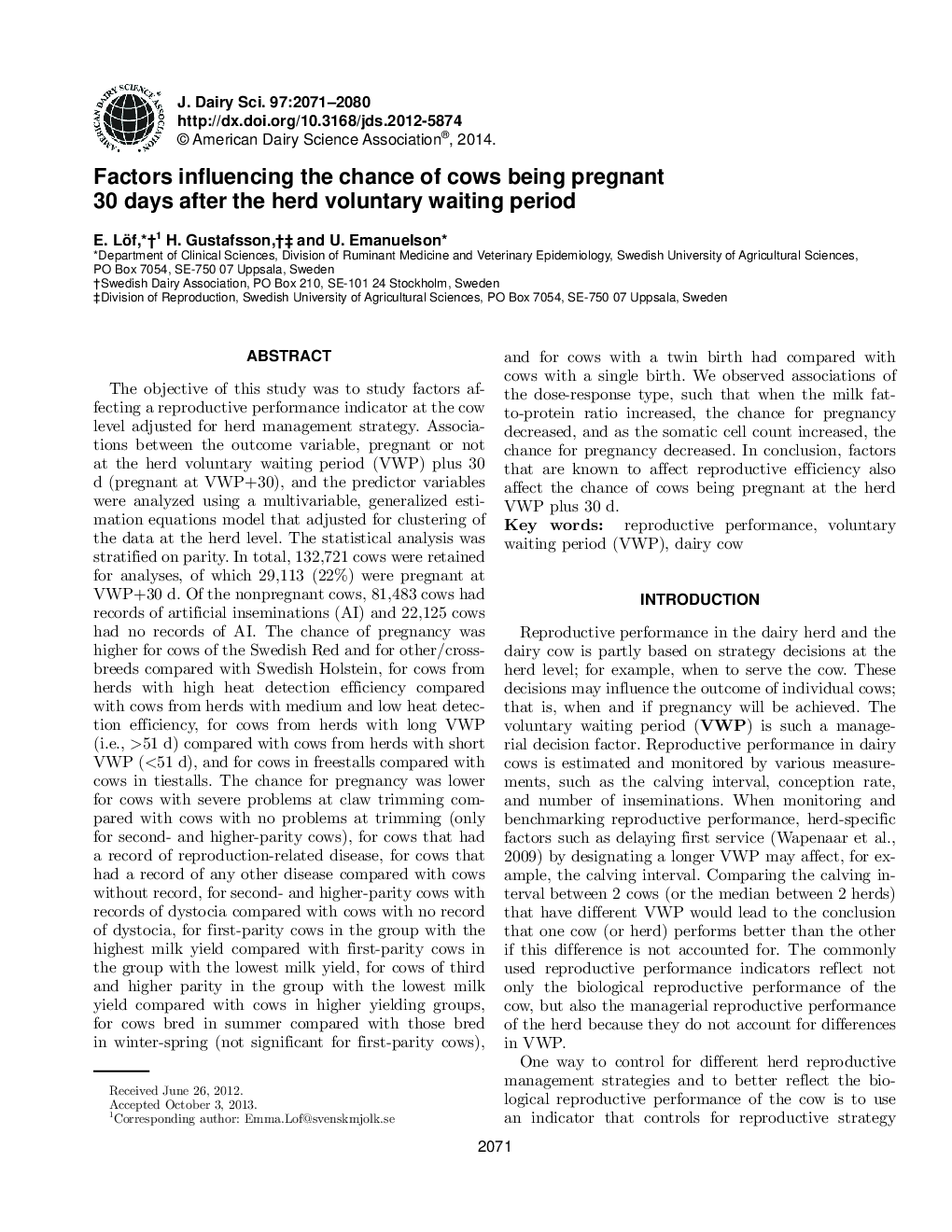| کد مقاله | کد نشریه | سال انتشار | مقاله انگلیسی | نسخه تمام متن |
|---|---|---|---|---|
| 10976654 | 1108043 | 2014 | 10 صفحه PDF | دانلود رایگان |
عنوان انگلیسی مقاله ISI
Factors influencing the chance of cows being pregnant 30 days after the herd voluntary waiting period
ترجمه فارسی عنوان
عوامل موثر بر احتمال گاو بودن باردار 30 روز پس از دوره انتظار داوطلبانه گله
دانلود مقاله + سفارش ترجمه
دانلود مقاله ISI انگلیسی
رایگان برای ایرانیان
موضوعات مرتبط
علوم زیستی و بیوفناوری
علوم کشاورزی و بیولوژیک
علوم دامی و جانورشناسی
چکیده انگلیسی
The objective of this study was to study factors affecting a reproductive performance indicator at the cow level adjusted for herd management strategy. Associations between the outcome variable, pregnant or not at the herd voluntary waiting period (VWP) plus 30Â d (pregnant at VWP+30), and the predictor variables were analyzed using a multivariable, generalized estimation equations model that adjusted for clustering of the data at the herd level. The statistical analysis was stratified on parity. In total, 132,721 cows were retained for analyses, of which 29,113 (22%) were pregnant at VWP+30Â d. Of the nonpregnant cows, 81,483 cows had records of artificial inseminations (AI) and 22,125 cows had no records of AI. The chance of pregnancy was higher for cows of the Swedish Red and for other/crossbreeds compared with Swedish Holstein, for cows from herds with high heat detection efficiency compared with cows from herds with medium and low heat detection efficiency, for cows from herds with long VWP (i.e., >51Â d) compared with cows from herds with short VWP (<51Â d), and for cows in freestalls compared with cows in tiestalls. The chance for pregnancy was lower for cows with severe problems at claw trimming compared with cows with no problems at trimming (only for second- and higher-parity cows), for cows that had a record of reproduction-related disease, for cows that had a record of any other disease compared with cows without record, for second- and higher-parity cows with records of dystocia compared with cows with no record of dystocia, for first-parity cows in the group with the highest milk yield compared with first-parity cows in the group with the lowest milk yield, for cows of third and higher parity in the group with the lowest milk yield compared with cows in higher yielding groups, for cows bred in summer compared with those bred in winter-spring (not significant for first-parity cows), and for cows with a twin birth had compared with cows with a single birth. We observed associations of the dose-response type, such that when the milk fat-to-protein ratio increased, the chance for pregnancy decreased, and as the somatic cell count increased, the chance for pregnancy decreased. In conclusion, factors that are known to affect reproductive efficiency also affect the chance of cows being pregnant at the herd VWP plus 30Â d.
ناشر
Database: Elsevier - ScienceDirect (ساینس دایرکت)
Journal: Journal of Dairy Science - Volume 97, Issue 4, April 2014, Pages 2071-2080
Journal: Journal of Dairy Science - Volume 97, Issue 4, April 2014, Pages 2071-2080
نویسندگان
E. Löf, H. Gustafsson, U. Emanuelson,
